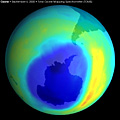
The Antarctic ozone hole is back to an average size, shrinking about 16% from last year’s record high, NASA said Friday. But it’s still the size of North America.
The ozone hole in mid-September reached its maximum for the year of 9.7 million square miles, down from its peak of 11.5 million square miles last year, said NASA atmospheric scientist Paul Newman.
The ozone hole was discovered in 1985, and at the current rate it should be closed up by 2070, Newman said.
Nearly 80% of the ozone-depleting chemicals in the atmosphere are man-made.











Social Profiles